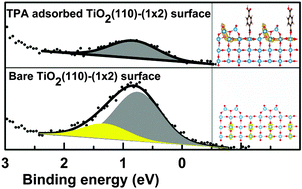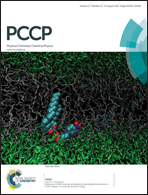Electronic structures of bare and terephthalic acid adsorbed TiO2(110)-(1 × 2) reconstructed surfaces: origin and reactivity of the band gap states†
Abstract
Combined core level spectroscopy, valence spectroscopy and density functional theory studies have probed the terephthalic acid (TPA) adsorption behavior and the electronic structure of the rutile TiO2(110)–(1 × 2) reconstructed surface at room temperature. The TiO2(110)-(1 × 2) reconstructed surface exhibits an electron rich nature owing to the unsaturated coordination of the surface terminated Ti2O3 rows. Deprotonation of TPA molecules upon adsorption produces both surface bridging hydroxyl (ObH) and bidentate terephthalate species with a saturation coverage of nearly 0.5 monolayers (ML). In contrast to the TiO2(110)-(1 × 1) surface, the band gap states (BGSs) on the bare (1 × 2) surface exhibit an asymmetric spectral feature, which is originated from integrated contributions of the Ti2O3 termination and the defects in the near-surface region. The Ti2O3 originated BGSs are found to be highly sensitive to the TPA adsorption, a phenomenon well reproduced by the density functional theory (DFT) calculations. Theoretical simulations of the adsorption process also suggest that the redistribution of the electronic density on the (1 × 2) reconstructed surface accompanying the hydroxyl formation promotes the disappearance of the Ti2O3-row derived BGS.


 Please wait while we load your content...
Please wait while we load your content...